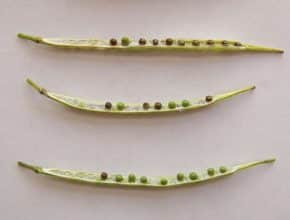In a situation where a field has matured more rapidly than expected and the majority of plants are beyond 80% seed color change, growers may be better off leaving the crop for straight combining. Swathing may result in costly losses…
Harvest
-
-
After a light frost of 0 to -2 C, damage is likely to be minor meaning swathing prematurely may do more harm than good. However, it is important to get out there and check crops to ensure damage is not greater than expected…
-
Some growers anxious about the calendar and the typical date of first killing frost are swathing canola early, at around 10-15% seed color change. At this stage, many seeds on the side branches may be watery and translucent. If this represents 30% of seeds, for example, growers must recognize that early swathing could mean sacrificing a large proportion of that…
-
Just because pods look dry and mature does not mean the seeds are ready for swathing. Sunscald and diseases such as blackleg, sclerotinia and clubroot can make plants look mature but the seeds may still be green. The opposite can also happen where pods look green but the seeds inside are ready. When assessing a canola crop to see if…
-
Cutting canola in hot conditions will lead to rapid dry down and desiccation. Chlorophyll may not have time to clear from immature seed, which locks in high green counts. If growers feel they must swath, wait until temperatures cool down in the evening and then swath at night to take advantage of those cooler temperatures and any moisture from dew…
-
Swathing early before the recommended 50 to 60% seed colour change in the high temperatures occurring lately will not necessarily mean earlier combining. Under hot, dry conditions crop dry down can occur quickly (drop below 10% moisture) but not crop curing (seed maturation and removal of chlorophyll). Fields that are swathed early (e.g. 20 or 30% seed colour change) and/or…
-
Scout fields individually and often. Determine swath timing by breaking open pods and assessing the level of seed colour change. Scouting based on field colour change is not a good indication of seed maturity. Maturity can change quickly and it may help to open up the field with a swath cut around the perimeter to grasp where the field is…
-
Swathing widths have increased in recent years to 30 feet and beyond. A heavy crop cut at thirty feet or more needs only gentle downward pressure on the middle of the swath to be anchored properly. Air movement within the swath is important during curing and dry down. The swath roller should lightly tuck edges. Being too aggressive with the…
-
A number of hail storms in Alberta earlier in the season have resulted in regrowth at the top of the plant. This regrowth is now considerably late and it is……
